A lesson in chemistry: Study abroad as catalyst
"When you change the way you look at things, the things you look at change." – Max Planck![At the German Cancer Research Institute [Deutsches Krebsforschungszentrum] dipeptide analysis lab. Courtesy Sam Rubin](/offices/revescenter/news/2023/heidelberg-photos/in-the-lab_large.png)
Abstract
The winter faculty-led study abroad program in Heidelberg, Germany, first conducted in January 2023 and led by Tyler Meldrum, shows study abroad can be an effective applied learning experience for any student, but especially students in STEM fields, and can help clarify life and career goals, as well as provide personal and professional growth and opportunities.
Introduction
Tyler Meldrum, associate professor of Chemistry and Director of Undergraduate Research in Chemistry, is just starting his eleventh year at W&M, and it was only in his 10th year that he began to consider leading a program himself. “I think that after ten years you understand the W&M student. You know how a program might fit. Timing is a large part of it. And there’s also having the confidence that you can go ahead and take a risk on the program.”
Meldrum attributes that confidence to a couple of things. “I had lived abroad [in Aachen, Germany],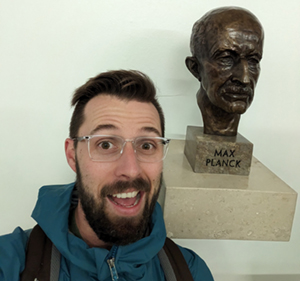 and it was such a valuable experience for me. And science is so international. We can do things in labs anywhere, but we really gain value by working with our international colleagues.”
and it was such a valuable experience for me. And science is so international. We can do things in labs anywhere, but we really gain value by working with our international colleagues.”
A science and lab-based program in Heidelberg would be unique, but the impetus for him was more than novelty; it was also the hope it would attract the kind of student seeking more than a challenging course to fulfill a requirement.
“I think [a student with] intellectual curiosity is one characteristic, and really wanting to understand how matter behaves—all of these things that William & Mary students in general want anyway. But I think the international component means that you have to be just a little bit brave. And I think that's the intent of COLL 300—to push boundaries and to let you explore. And I think that being a little bit willing to get lost, a little bit willing to step into the unknown and try something, be it traveling, be it food, be it whatever—I think that little bravery, that willingness to do new things—that's the thing that makes the difference in my mind.”
Materials and methods: Faculty & staff collaboration
Meldrum’s first step was to reach out to a friend and colleague in Heidelberg: Dr. Leif Schröder, director of the Division of Translational Molecular Imaging at the German Cancer Research Institute [Deutsches Krebsforschungszentrum]. They had known each other as postgraduates at Berkeley.
“I contacted him probably December of 2021. I said, ‘I have this kind of crazy idea. I want to put in an application to bring a student group.’ And he said, ‘That sounds great. I'd be happy to help.’ And it just kind of ballooned from there.”
As with all new study abroad programs, there was an application process, beginning with consultation with Reves Center staff and then submitting the proposal to the International Study Advisory Committee (ISAC) and the Educational Policy Committee (EPC), both in Arts & Sciences.
“I reached out first and said, ‘I have this idea. I'm not sure how I can pull it off. I can't see the final product yet, but I know there's value here,’ and the Reves Center was very supportive from the get-go,” he recalls. “That's where a lot of the brainstorming came together, and we found a way to piece it together.”
Sylvia Mitterndorfer, Director of the Global Education Office and Global Partnerships at the Reves Center, was on board from the very beginning. “[Tyler and I] had corresponded all the way back in 2018 about study abroad for Chemistry majors in general. I was very excited to hear of Tyler’s idea of a Chemistry program in Germany given that we have been actively working to increase study abroad opportunities for STEM students. We had a great conversation about what a proposal could look like and how to make connections to the learning objectives of COLL300. In 2021-22, ahead of the RFP deadline for winter 2022-23, we spoke and emailed as Tyler was preparing his proposal.”
Winter break has been increasingly popular for majors in the sciences, as it doesn’t interfere with semester and summer commitments. “Tyler’s proposal, therefore, met multiple criteria and helps address the needs of STEM students. It is also an incredible opportunity to get access to labs, meet scientists in a multinational context, and learn about global careers in the sciences,” Mitterndorfer explains.
Over the course of the three-week program, students would learn molecular and clinical imaging while studying at renowned research centers, including the German Cancer Research Center, the European Molecular Biology Laboratory, and the Max Planck Institute for Medical Research. In addition to academic curriculum, the program would include visits to explore Heidelberg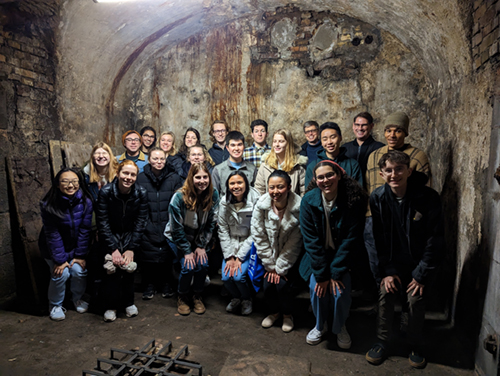 and nearby towns, learning about history and culture, and visiting other organizations and labs, including a hospital.
and nearby towns, learning about history and culture, and visiting other organizations and labs, including a hospital.
There was of course lab work and lectures, and students had to do a literature review on some contemporary magnetic resonance research as well as give a final presentation on a molecular imaging topic of their choice.
To succeed, it would require excellent preparation as well as execution.
Materials and methods: Students
There were twenty students in the first cohort. “The majority of students were bio/neuro/chem majors. But we had an econ major. So, there was a broad range of interests and focus. Generally, they had an interest in health imaging or physics itself,” Meldrum explains.
He required that students have one semester of general chemistry and one semester of organic chemistry, so one year total of chemistry as a prerequisite. “But it's a very gentle prereq, especially for students who are coming in with an interest in premed, because that's half of the chemistry requirement you have to knock out early on.”
His goal was not to exclude anyone, as much as to ensure students had the preparation to succeed. “In the first semester of organic chemistry, students learn the very basics of magnetic resonance. And so, they know what I mean if I say, ’This molecule is a hydrocarbon; this molecule is an alcohol; this is an ester.’ So, then we can start interpreting the data that we're getting instead of thinking about the underlying terminology.”
In addition to the prerequisite, a key part of the preparation (as with any W&M faculty-led study abroad program), was a one-credit course in the semester leading up to the program. During the fall they had classes that covered the basic physics and chemistry that underlie magnetic resonance--how an MRI works, basically.
Sam Rubin ’24 was one of the students on the Heidelberg program. “At the moment I'm a chemistry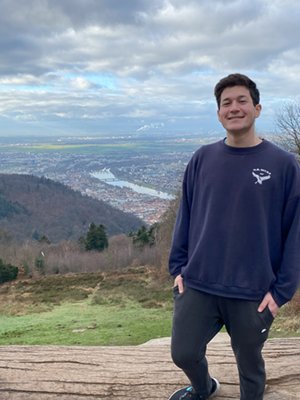 major and physics minor, but I want to be a doctor.” He’s considering radiology or biomedical imaging as a career. Put him and Meldrum in a room together to discuss the program, and the intellectual energy is both palpable and, well, magnetic.
major and physics minor, but I want to be a doctor.” He’s considering radiology or biomedical imaging as a career. Put him and Meldrum in a room together to discuss the program, and the intellectual energy is both palpable and, well, magnetic.
“I was super excited for this program because I've been working in Tyler's lab for about two years now, and I've done most of my work on single-sided NMR (nuclear magnetic resonance). The program was focused on a certain niche topic, but you could expand it out to a broader picture of general biomedical imaging of human beings -- tissue, muscles, skeletal – so it fit my interests very well.”
Rubin explains that in Meldrum’s lab, the size of what they can scan is different, but the principles are the same. “The actual MRI machine itself is very different from a typical NMR or different magnetic resonance instrument. Downstairs in ISC, we have a vertically standing magnetic resonance instrument and it takes only about a 5-millimeter tube -- a tiny tube of a liquid sample.”
An MRI that one would find in a hospital or diagnostic clinic is much larger, takes up an entire room, has safety precautions and requires special training.
That level of training is not feasible for undergraduates, especially on a three-week program.
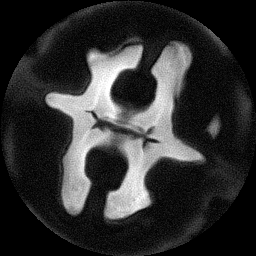 But in Heidelberg, they did have access to a larger machine than at W&M. “We didn't get human-sized MRIs, but we were working with an NMR instrument that is a wide bore, so around 30 millimeters or over an inch in diameter,” Rubin says. “That allowed us to examine a tomato or cherries -- things that have hard and soft tissue to show contrast -- not necessarily human-sized, but still more than we
But in Heidelberg, they did have access to a larger machine than at W&M. “We didn't get human-sized MRIs, but we were working with an NMR instrument that is a wide bore, so around 30 millimeters or over an inch in diameter,” Rubin says. “That allowed us to examine a tomato or cherries -- things that have hard and soft tissue to show contrast -- not necessarily human-sized, but still more than we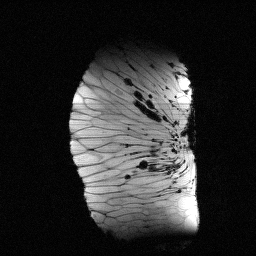 have in Williamsburg.”
have in Williamsburg.”
In Heidelberg lectures complemented the hands-on lab work, and Rubin saw that as useful. “There was a healthy number of lectures. We were talking about: How do you image? How do you know what molecules look like when you can't see them? How do you know what's inside a human when you don't want to dissect them? And how can we use this magnetic resonance to do it?”
Meldrum even included an opportunity for any students in premed or considering premed to connect with someone working in the field. “My brother is a radiologist. And he zoomed into the program and gave a talk about his experience as a radiologist.”
 They continued learning outside of the lecture hall and lab, taking day trips to surrounding cultural and educational sites. “We visited the German Röntgen Museum, in Würzburg, where X-rays were discovered. We looked at 100-year-old examples of how people found out how to take pictures of what's in the human body,” Meldrum recalls. “That was the first time scientists could see what it looks like without even cutting it open. So, it hit both aspects of the chemistry and physics of the research, but especially the pre-med aspect.”
They continued learning outside of the lecture hall and lab, taking day trips to surrounding cultural and educational sites. “We visited the German Röntgen Museum, in Würzburg, where X-rays were discovered. We looked at 100-year-old examples of how people found out how to take pictures of what's in the human body,” Meldrum recalls. “That was the first time scientists could see what it looks like without even cutting it open. So, it hit both aspects of the chemistry and physics of the research, but especially the pre-med aspect.”
The group also visited the Max Planck Institute for Astronomy for a “lesson” especially compelling for Meldrum. “We talked with people about how they designed instruments for these very sophisticated telescopes, James Webb among them. We also saw a lot of ground-based telescopes that are doing radio imaging and trying to understand more and more. We asked them: ‘Our program has been about looking at molecules that you can't see inside of people that you can't see. You can't go and just see a star. How do we use these measurements to interpret what's happening based on the physics?”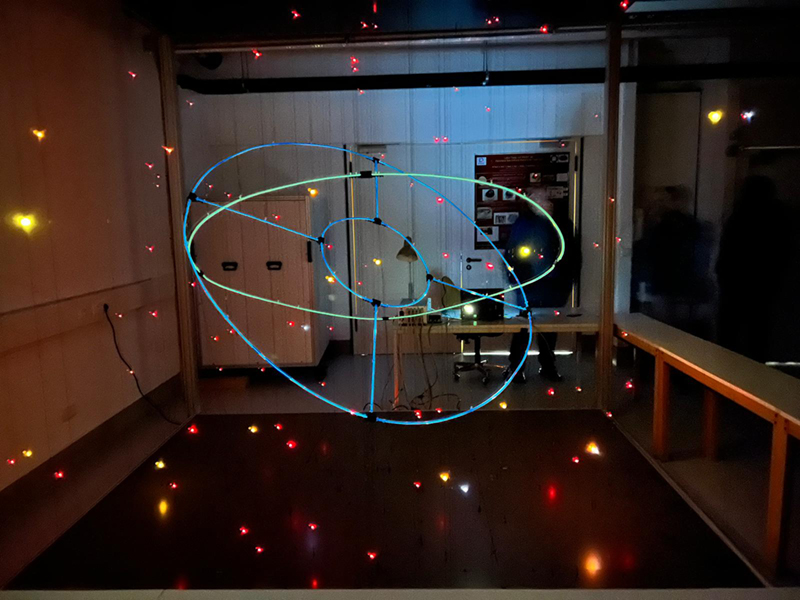
Rubin remembers, “We had a lecture from one of the scientists about the experimental optics they were doing, which arguably was above, I think, everyone in the room. It was fantastic, but deeply complicated.” Meldrum concurs: “It was fascinating but deeply complicated.” And deeply rewarding.
Discussion: Collegiality and respect
And that experience of a high-level scientific lecture illustrates another important element of the program experience: The students, although undergraduates, were treated as intellectual peers.
“Maybe Sam's experience was different, but I certainly got the sense that they knew that their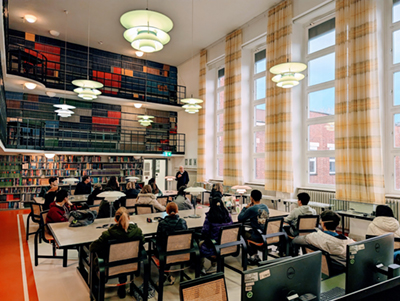 audience, that we weren't doing new research at the time –that this was three weeks of education, not developing new knowledge,” Meldrum says. “But at the same time, they weren't afraid of actually talking about the experiments in full technical terms.”
audience, that we weren't doing new research at the time –that this was three weeks of education, not developing new knowledge,” Meldrum says. “But at the same time, they weren't afraid of actually talking about the experiments in full technical terms.”
Rubin concurred. “That's my experience as well. I think the lectures were a good replacement for what we would have gotten in a 300 or 400 level upper class chemistry elective.”
The time on the Heidelberg program wasn’t an interesting side experience but a chance to apply what they learned. Rubin is enthusiastic about the quality and content of the information “You took a fundamental that you learned, and you applied it in different and more advanced and more technical ways, and you built on what you already knew. As for the labs, some of them were pretty advanced, but some of them at the same time were like a teaching lab. It was similar to what you would find in an undergrad lab where it's not groundbreaking research, but if you don't understand this, there's no way you can get any further in the field.”
Rubin expresses no sense of boredom or impatience with the curriculum. “You had to learn the fundamentals, the basics, the actual, like mechanisms of action, of nuclear magnetic resonance, which was the theme of this, of how of how these actual molecules interact on a microscopic nanoscale.” And he emphasizes, “It was an opportunity for us to learn but also for us to ask questions and for us to engage with the material.”
The high caliber of the curriculum and interactions was due in large part to Meldrum’s own experience and to the partner he chose. “My connections in Heidelberg came from Dr. Schröder. He was a postdoc in the same lab in California where I was a grad student. So, he also had these interests in this cross-national collaboration, and he understood a little bit about how the American system works. Both of us, because we had an interest in working with each other, were able to find common ground: How do we use the technical expertise, the instrumentation, the engineering skills that the Germany side has, coupling it with the William and Mary style education of bringing students along through the lab and the theory? And I think that because we understood each other's goals that way, it really worked well for undergraduates to be able to see what's happening at a cutting-edge facility.”
The program culminated in final presentations, and they did not disappoint.
Meldrum’s students produced a “wide and fascinating range of themes” from how airport scanners work with millimeter wave and how that's used as an imaging technique, to identifying the provenance of wine using magnetic resonance, to pure NMR theory and how you can relate molecular scale behaviors with macroscopic observables.
Rubin’s presentation was on PET-CT, clinical imaging focused on detection of cancer through radioactive glucose. He was impressed with the work of his fellow students.
“I worked on mine, and I knew mine front and back, and everyone else learned theirs front and back and could answer questions and could take different feedback. It was very cool to see people delve into their own realms and apply what we learned to what they're interested in,” Rubin explains. “I didn't know how much range there would be in this field, but with the presentations on different imaging techniques, I didn't know half the things people were talking about and they seemed so passionate --in a week to put together a 10- to 15-minute oral presentation, and each of them brought such different aspects into the presentation itself.”
Successful Outcomes: Programmatic, academic, personal and professional
Mitterndorfor sees the Heidelberg program as a success on multiple levels. “Students benefited greatly from Tyler’s expertise in his field, connections with scientists in Heidelberg, and his own experience having lived and studied abroad. This program has added substantively to the winter portfolio of options, and we seek to continue to increase winter study abroad options for students. Tyler’s program is a great example of how international research collaborations by W&M faculty can open doors to global experiences for W&M students. We are so grateful to Tyler for his enthusiasm and support of study abroad."
For the program director, who conceived of the program and saw it through from start to finish, there was satisfaction in accomplishing what he’d set out to do.
“I remember one night when one of the students was trying to piece together some of their thoughts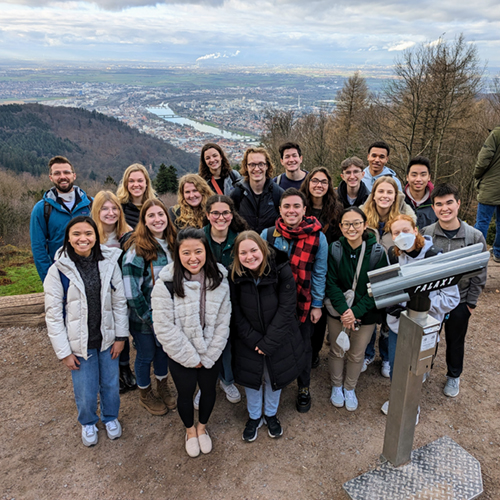 for their presentation, and they couldn't figure out when we could meet," Meldrum remembers. "So, we just walked up and down the main street and talked science as we were strolling through downtown Heidelberg. It was really memorable.” And later at the final dinner celebration, Meldrum had a similar sense of accomplishment. “It was so satisfying to just sit back and look at a group that had really made progress in terms of the science, and they had good cohesion. It was really satisfying to sit back and see that we did it.”
for their presentation, and they couldn't figure out when we could meet," Meldrum remembers. "So, we just walked up and down the main street and talked science as we were strolling through downtown Heidelberg. It was really memorable.” And later at the final dinner celebration, Meldrum had a similar sense of accomplishment. “It was so satisfying to just sit back and look at a group that had really made progress in terms of the science, and they had good cohesion. It was really satisfying to sit back and see that we did it.”
He is currently preparing to lead the second cohort in January.
In addition to the intellectual stimulation and exploration and transformative life experience, it also had tangible effects on career choices for some students.
Meldrum expresses a certain amount of unabashed glee in reporting one unexpected outcome: “The econ major is now an econ-chemistry double major. She was persuaded.”
For a student like Rubin, who went on the program with fairly clear plans for his future, the experience broadened his options and his outlook in ways he hadn’t anticipated.
He began thinking about doing more research abroad and he found an opportunity that was “even bigger and better [than in Heidelberg] and really cool!”
“Without even really thinking about it, the experience in Heidelberg set me up for success for a summer research program as well.”
The catalyst for Rubin was the summary review project Meldrum included in the curriculum—where students were assigned a research article and had to put it in some context: What does this mean? How do I understand this? How is this related to some other ideas or projects I've thought about?
“There were 8 or 10 papers that were arguably seminal in the field of magnetic resonance imaging and MRI theory,” Rubin recalls. “And one of the papers—not even the one I ultimately reviewed!--was proposing a new and better way of doing things [The Acquisition of multidimensional NMR spectra in a single scan]. When I started the paper, I looked up one of the authors and found there's a summer research program at his institute, the Weizmann Institute of Science in Rehovot, Israel. I applied to it, and I got an initial response while in Germany and later, an acceptance. So I continued my journey in the field of magnetic resonance and different types of imaging in Israel this summer.”
Heidelberg was an important steppingstone to the Weizmann Institute, the next phase in his research career, and one he hadn’t seen as an option before the program.
“It was very different from William & Mary or Germany: William & Mary is predominantly undergrad focused and focused on teaching one-on-one; and in Germany it was more lab group based or exploration based. Then I got to Weizmann, and it’s a true research institute. There are no undergrads. [Weizmann is a public university that offers postgraduate degrees only.] Everyone is 30 and a professional with 3 degrees. So arguably quite intimidating. But it meant that there was no holding back. They wouldn't go easy on me.”
And from the joy in his voice and in his expression as he describes it, he clearly relished the challenge.
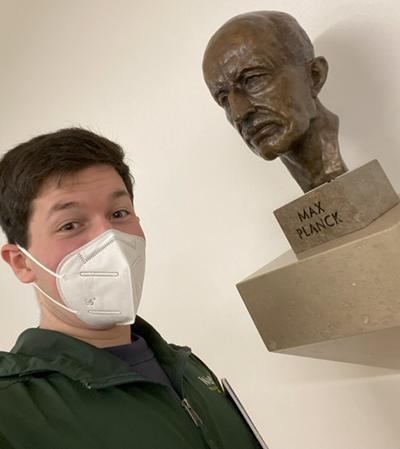 Which takes us back to Meldrum’s original hope for what a student would both bring to, and gain from, the experience: “… being a little bit willing to get lost, a little bit willing to step into the unknown and try something … I think that little bravery, that willingness to do new things -- that's the thing that makes the difference.”
Which takes us back to Meldrum’s original hope for what a student would both bring to, and gain from, the experience: “… being a little bit willing to get lost, a little bit willing to step into the unknown and try something … I think that little bravery, that willingness to do new things -- that's the thing that makes the difference.”
Rubin expresses no doubt about the value of the program in Heidelberg for him as preparation for his next step and future steps: “What I learned in Germany, and what I learned at W&M, really set me up to just fly right in and pick up on what’s going on.”
 Skip to main content
Skip to main content
